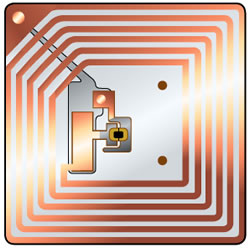RFID Looks Better Without The Hype
|
|
As technology priorities go, RFID seems to be the cheese that slipped off the cracker. You may remember the projections for market adoption that were being tossed around five or six years ago that never came close to reality. As recently as two years ago, the marketing drums still beat loudly. Business focus on cost containment and risk avoidance put the double whammy on RFID. Didn’t kill it–activity can still be found in niches such as the apparel and electronics industries–but the drums are noticeably quieter. Maybe that’s a good thing, because it’s much easier to see the supply chain reality now that IDC, Gartner, Aberdeen, and the others have other songs that top their charts. Can’t blame them, it’s hard to dance when the theme music is playing in slow motion. |
|
In a blog by analyst Robert Parker describing the recent IDC Retail Insights conference, it was noted there is “great opportunity for putting devices in the hands of associates to improve process execution based on improved interfaces and better data handling. Even RFID, as well as other sensors, were part of the conversation as technology improvements and organizational understanding are creating the opportunity to revisit this type of investment.” The key word in that description is revisit. As I understand the word, it means no one has been visiting for a while. If you’re a supply chain manager, the best way to keep your job is to continually squeeze costs from your supply chain. Can you do that and implement RFID? You wouldn’t think so based on the faded RFID headlines. But need I remind you enthusiasts of the IBM i platform that just because you don’t make headlines in the major trade magazines and are generally ignored by the name-brand analyst firms doesn’t mean that life ceases to exist. The apparel and electronics industries mentioned earlier are huge economic engines and behind the scenes are plenty of top companies running on the IBM i platform. Coincidently, there’s RFID action here, too. “We’ve been busy putting in RFID systems,” says Sheldon Reich, vice president of Cybra, a Yonkers, New York-based software company with products that generate RFID tags, bar code labels, and other types of forms and products that communicate with RFID devices and integrate that data back into ERP and WMS systems. “In the apparel industry, there’s been a push by a number of the retailers for item-level RFID tagging,” Reich says. “In the early years, there were a carton- and pallet-level RFID mandates. In that early testing, the payback wasn’t there. But it was later discovered that payback was much better on fast-moving consumer items that are hard to keep in inventory. Retailers found they could reduce the number of ‘out of stocks’ resulting in lost sales.” Reich sites studies done at the Sam M. Walton College of Business at the University of Arkansas and pilot programs done by top retailers. Cybra has its own survey of more than 100 companies, which it uses to demonstrate increased interest in RFID. No big surprise there. Just about everyone selling a product has a survey that shows people like the product. (You know what I mean?) In this case, the survey results indicate RFID is being used or is in the testing and implementation stage at more than 34 percent of the organizations Cybra chose to survey. This is a 21 percent increase over a previous RFID survey conducted by Cybra in 2008. The major force behind these numbers is the Electronic Product Code mandate, a set of RFID technology standards for the tracking of individual products, as well as shipping containers. EPC is similar to the Universal Product Code (UPC), which standardizes bar code tracking of consumer goods. So, to me, the survey shows there are more companies lining up to get on the mandate train. And to Cybra’s credit, it is not trying to hide this fact. Over in the apparel industry, four of the top ten retailers have RFID compliance mandates for their vendors. That list includes Macy’s JC Penney, Dillards, and Wal-mart. Michael Shabet, vice president of marketing at Cybra, explained the mandates identify certain categories of items coming into stores. The categories share one common trait: a large number of SKUs in the style pool. For the retailers, the primary goal is to maintain visibility to the inventory at the retail level. The manufacturers, Shabet says, have to source the tags and mange the serialization of the tag numbering. Decisions are being made to do these things in-house or have it outsourced to a service bureau. Among their goals is to reduce the amount of returned merchandise. This is where the software comes into play along with the capability to drive the output devices–printers and coders. After generating the RFID tag on the item level, a tag-reading system is used to validate outbound shipments by serial numbers. Another recent addition to these systems is the capability to produce an electronic proof of delivery. As Shabet points out, in the early going there was no payback for the manufacturer or supplier. The benefits were all on the side of the giant organization making the mandates. RFID benefits–include real-time accounting of warehouse inventory, optimized loading and unloading, and triggering inventory replenishment–are changing the game, according to the Cybra VPs. That equalization of benefits could spark new interest. Shabet predicts a lot of activity in 2012. Some people haven’t looked at RFID for years, and in this technology racket a year is like 25 years. The technology–the readers, the antennae, the fabrication of the labels–have all advanced. The improvements in reliability and accuracy are substantial, he says. Retail store inventories are being done in an hour, he boasts. Will this be enough to overcome the early problems with unreliability and the complaints about high implementation costs? We’ll see. Performance must match the promises. According to the IBM report The Smarter Supply Chain of the Future, supply chains have become much more global and involve more companies. This places a strain on continually wringing efficiencies from the system as suppliers are more frequently replaced and suppliers’ product inventories grow and shrink. Greater supply chain volatility brings with it increased risk. To limit risk means introducing methods of increased collaboration. While alignment and realignment of supply chains is one element of a business strategy, the other areas of continuing concern are continuous process improvement and cost reduction. RFID has been hailed as the better way forward because of its benefits in improved collaboration–the exchange of real-time information and added visibility that leads to workflow efficiencies–and, ultimately, cost reductions. That sounds pretty good when you read it. That’s what’s called marketing–selling the sizzle. If this all plays out as advertised, we could see RFID back in the headlines again. For that to happen, adoption rates have to increase. Companies will be choosing to implement RFID rather than being mandated to use it. And technology will have to open more doors. As an example, last week an RFID advancement produced thin-film chips based on “reader-talks-first” communication. This bodes well for item-level tags on the packaging of retail consumer goods. Traditional RFID tags with such thin-film chips on plastic are based on the “tag-talks-first” principle, which means the RFID tag gets its power from the RFID reader. The problem with this is that many tags will try to contact the reader at the same time. With reader-talks-first technology, it’s possible to have an “anti-collision scheme” for the thin-film RFID tags. They are said to be potentially inexpensive enough for use on mass-produced retail products. The tags support retail applications that include automated billing and inventory management, as well as information on price, characteristics, and freshness. |
|
| Source : http://www.itjungle.com/tfh/tfh030512-story03.html Image source : http://www.newscientist.com/blog/technology/uploaded_images/rfid-716135.gif |
|







